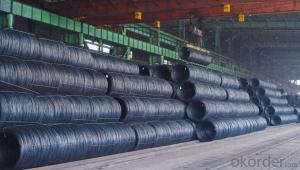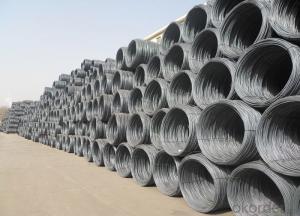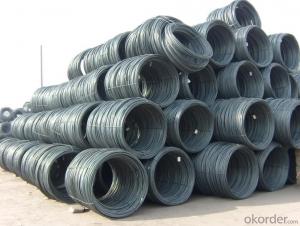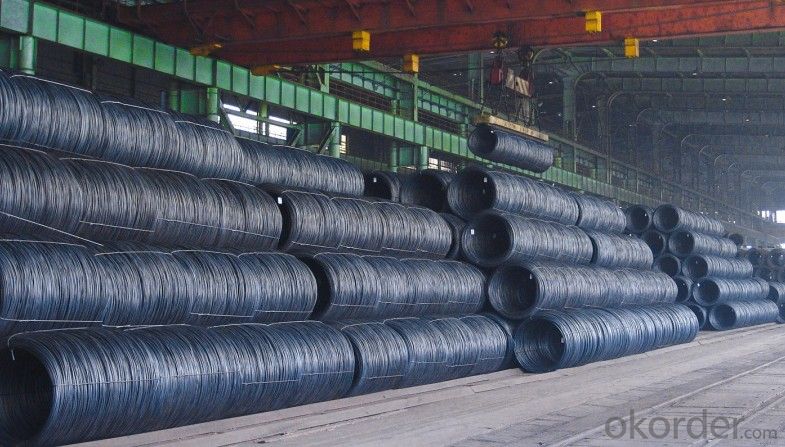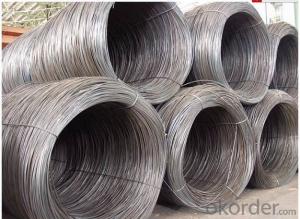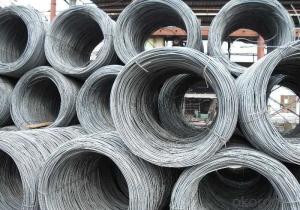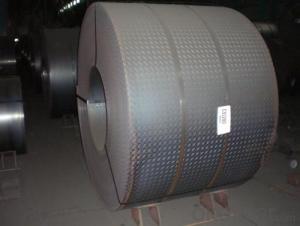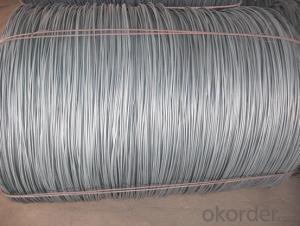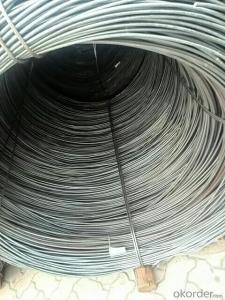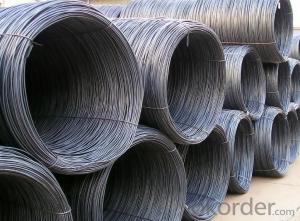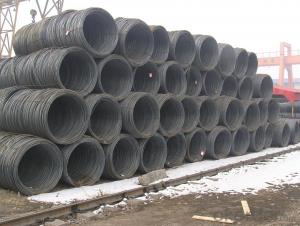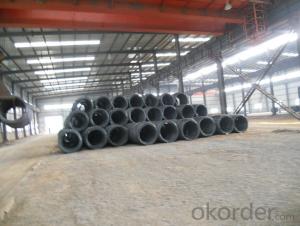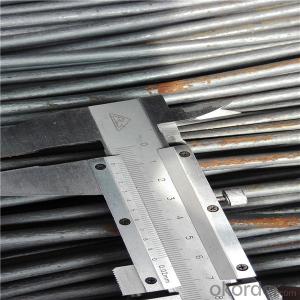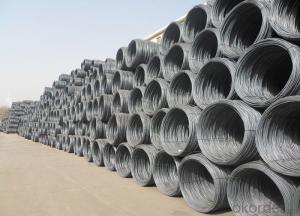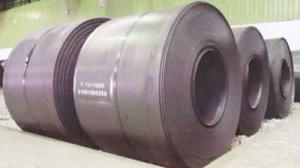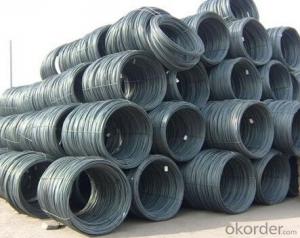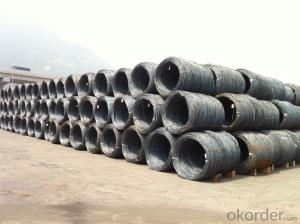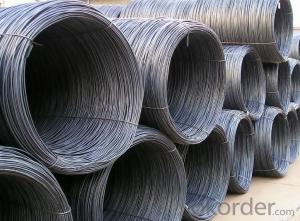Prime Hot Rolled Alloy Steel Wire Rods in Coil
- Loading Port:
- China main port
- Payment Terms:
- TT OR LC
- Min Order Qty:
- 100 m.t.
- Supply Capability:
- 10000 m.t./month
OKorder Service Pledge
OKorder Financial Service
You Might Also Like
Product Description:
OKorder is offering Prime Hot Rolled Alloy Steel Wire Rods in Coil at great prices with worldwide shipping. Our supplier is a world-class manufacturer of steel, with our products utilized the world over. OKorder annually supplies products to African, South American and Asian markets. We provide quotations within 24 hours of receiving an inquiry and guarantee competitive prices.
Product Applications:
Prime Hot Rolled Alloy Steel Wire Rods in Coil are ideal for structural applications and are widely used in construction and manufacturing. Carbon steel wire rod is mainly used for reinforcement of reinforced concrete and welded structure or reprocessed (roberts , nail, etc.) materials, especially used to produce wire drawing, welding electrode, nails, spring, electronic, precise machinery parts and so on.
Product Advantages:
OKorder's Prime Hot Rolled Alloy Steel Wire Rods in Coil are durable, strong, and wide variety of sizes.
Main Product Features:
· Premium quality
· Prompt delivery & seaworthy packing (30 days after receiving deposit)
· Can be recycled and reused
· Mill test certification
· Professional Service
· Competitive pricing
Product Specifications:
Steel Grade: SAE1006-1018B
Standard: ASTM, GB
Diameter: 5.5mm, 6.5mm, 7mm,8mm,9mm,10mm,12mm,14mm
Type: in coil, coil weight around 2MT
Alloy or Not: Alloy
Technique: Hot Rolled
Place of Origin: China Mainland
Surface: round, no twisted, light and smooth
FAQ:
Q1: Why buy Materials & Equipment from OKorder.com?
A1: All products offered byOKorder.com are carefully selected from China's most reliable manufacturing enterprises. Through its ISO certifications, OKorder.com adheres to the highest standards and a commitment to supply chain safety and customer satisfaction.
Q2: How do we guarantee the quality of our products?
A2: We have established an advanced quality management system which conducts strict quality tests at every step, from raw materials to the final product. At the same time, we provide extensive follow-up service assurances as required.
Q3: How soon can we receive the product after purchase?
A3: Within three days of placing an order, we will arrange production. The normal sizes with the normal grade can be produced within one month. The specific shipping date is dependent upon international and government factors, the delivery to international main port about 45-60days.
Images:
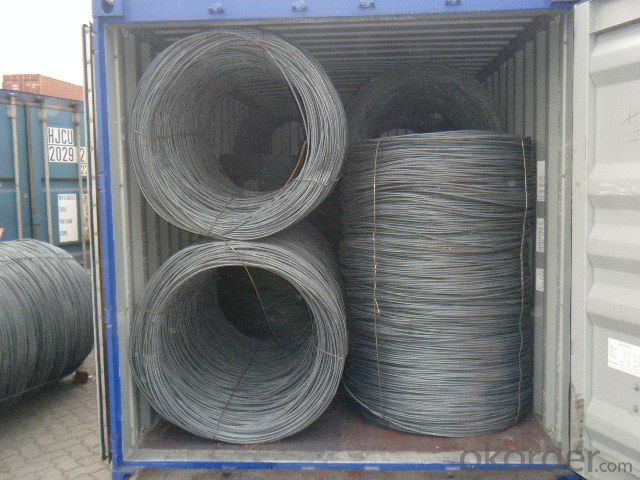
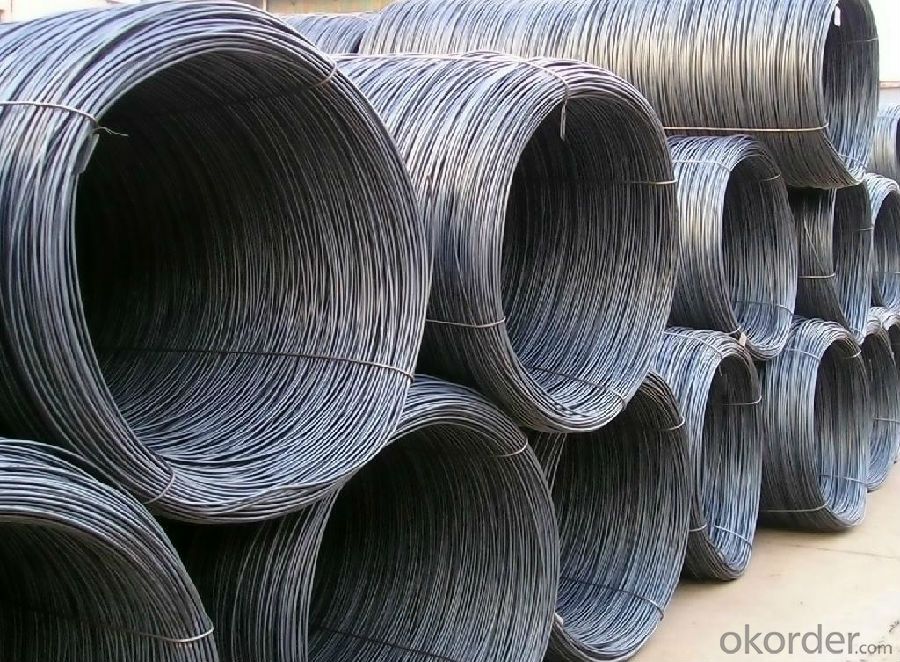
- Q: What are the common tensile strengths of steel wire rod?
- The specific grade and composition of the steel determine the common tensile strengths of steel wire rods, which can vary. Steel wire rods typically have tensile strengths ranging from 500 MPa to 2000 MPa. It is worth mentioning that these values are approximations and may slightly differ based on factors like the manufacturing process and the application of the steel wire rod. Furthermore, different industries may have varying standards and demands for tensile strength, so it is advisable to refer to the appropriate standards and specifications for precise information.
- Q: How does the price of steel wire rod fluctuate in the market?
- The market for steel wire rod experiences price fluctuations due to various factors. One significant factor is the dynamic between supply and demand within the steel industry. When there is a strong demand for steel wire rod, such as during periods of economic growth or construction booms, the price tends to rise. Conversely, when there is a decrease in demand or an oversupply of steel wire rod, the price tends to drop. Another factor that impacts the price of steel wire rod is the cost of raw materials. Typically, steel wire rod is produced from iron ore, which is subject to price changes in the global market. If the cost of iron ore increases, it can lead to higher production costs for steel manufacturers, resulting in higher prices for steel wire rod. In addition, fluctuations in energy prices can influence the price of steel wire rod. Steel production requires a significant amount of energy, particularly in the form of electricity and natural gas. If energy prices rise, it can increase production costs and ultimately lead to higher prices for steel wire rod. Moreover, changes in trade policies and tariffs can also have an impact on the price of steel wire rod. Governments may impose tariffs or trade restrictions on steel imports, which can limit the supply of steel wire rod in the market and potentially raise prices. Lastly, market speculation and investor sentiment can also contribute to price fluctuations in the steel wire rod market. Investors and traders may anticipate future changes in supply and demand or react to economic indicators, resulting in volatile price movements. In summary, the price of steel wire rod is influenced by a range of factors, including supply and demand dynamics, raw material costs, energy prices, trade policies, and market speculation. These factors can cause the price to fluctuate in response to changes in the broader economy and industry conditions.
- Q: How is steel wire rod used in the manufacturing of wire ropes for cranes?
- Steel wire rod is used as the primary material in the manufacturing of wire ropes for cranes. It undergoes a series of processes such as drawing, stranding, and coating to transform it into a strong and durable wire rope. The steel wire rod provides the necessary tensile strength and flexibility needed to lift heavy loads and withstand the demanding conditions of crane operations.
- Q: What are the standard lengths available for steel wire rod?
- Steel wire rods are available in a variety of standard lengths, which are typically measured in feet or meters. The most common standard lengths for steel wire rods range from 6 to 12 meters (20 to 40 feet). However, it is important to note that the specific standard lengths of steel wire rods can vary depending on the manufacturer and the intended application. Additionally, custom lengths can often be requested and produced to meet specific project requirements.
- Q: What are the different types of steel wire rod surface defect prevention techniques?
- There are several types of steel wire rod surface defect prevention techniques, including surface cleaning, coating application, heat treatment, and proper handling and storage practices. Surface cleaning involves removing any contaminants or impurities from the wire rod surface to prevent defects. Coating application involves applying protective coatings or lubricants to the wire rod surface to prevent oxidation, rusting, or other forms of surface damage. Heat treatment techniques such as annealing or quenching can be employed to enhance the strength and resistance of the wire rod surface. Lastly, proper handling and storage practices, such as avoiding excessive bending or stacking, can prevent surface defects caused by mechanical stress or external factors.
- Q: How is the microstructure of steel wire rod analyzed?
- The microstructure of steel wire rod is analyzed using various techniques and methods to understand its properties and quality. One common method is metallography, which involves preparing a sample of the steel wire rod by cutting and polishing it to create a flat and smooth surface. The prepared sample is then etched with a chemical solution to reveal the microstructure under a microscope. Optical microscopy is often used to analyze the microstructure of steel wire rod. It allows for the observation of various features such as grain size, grain boundaries, and the presence of any impurities or defects. This technique provides valuable information about the quality and performance of the steel wire rod. Another widely used technique is scanning electron microscopy (SEM). SEM provides a higher magnification and resolution compared to optical microscopy, allowing for more detailed analysis of the microstructure. It can reveal the surface morphology, grain boundaries, and the presence of any precipitates or phases in the steel wire rod. Transmission electron microscopy (TEM) is a more advanced technique used for analyzing the microstructure of steel wire rod. It involves preparing an extremely thin sample, typically less than 100 nanometers thick, which is then examined using an electron beam. TEM provides even higher resolution and can reveal the atomic structure, dislocations, and other fine details of the microstructure. In addition to microscopy techniques, other methods such as X-ray diffraction (XRD) and electron backscatter diffraction (EBSD) can also be used to analyze the microstructure of steel wire rod. XRD helps in identifying the crystallographic phases present in the steel wire rod, while EBSD provides information about the crystal orientations and texture. Overall, the analysis of the microstructure of steel wire rod is crucial for understanding its mechanical properties, durability, and potential applications. These various techniques and methods enable researchers and manufacturers to assess the quality and ensure the desired microstructure for specific purposes.
- Q: What are the main factors influencing the choice of steel wire rod production process?
- Several key factors influence the selection of the steel wire rod production process. Firstly, the quality requirements of the final product play a vital role. Each production process has its own capabilities in producing steel wire rods with specific properties such as strength, ductility, and surface finish. The desired characteristics of the wire rod will determine the appropriate production process. Secondly, the cost-effectiveness of the production process is an important consideration. The overall cost of production can be significantly affected by factors like energy consumption, raw material utilization, and labor requirements. It is crucial to evaluate the efficiencies and costs of different processes to make the most economical choice. Moreover, the availability and cost of raw materials also impact the selection of the production process. Steel wire rods can be made from various types of steel, including carbon steel, alloy steel, or stainless steel. The choice of raw material depends on factors such as required mechanical properties, availability, and cost. The production process must be compatible with the chosen raw material. Another factor to consider is the production capacity and scalability of the process. Some processes are more suitable for small-scale production, while others are better suited for large-scale manufacturing. The desired production volume and scalability requirements must be taken into account to ensure the chosen process can meet the production demands. In addition, environmental considerations can also influence the choice of production process. Some processes may generate more waste or emit higher levels of pollutants compared to others. Companies may prioritize sustainable and environmentally friendly production methods, leading them to select a process that minimizes environmental impact. Overall, the selection of the steel wire rod production process is influenced by factors such as desired product quality, cost-effectiveness, availability and cost of raw materials, production capacity and scalability, and environmental considerations. A careful evaluation of these factors is necessary to choose the most suitable production process for a specific application.
- Q: What are the common production processes for manganese-coated steel wire rod?
- The common production processes for manganese-coated steel wire rod include wire drawing, cleaning and coating. Wire drawing involves pulling the steel wire rod through a series of dies to reduce its diameter and improve its surface finish. After wire drawing, the wire rod goes through a cleaning process to remove any contaminants or scale. Finally, the wire rod is coated with a layer of manganese through a chemical or electroplating process to enhance its corrosion resistance and mechanical properties.
- Q: What are the different types of surface defects in steel wire rod?
- Steel wire rods can experience various surface defects. Some common ones include: 1. Scale: During manufacturing, a thin oxide layer called scale can form on the wire rod's surface. This can occur due to the steel's reaction with oxygen in the air or other elements in the production environment. Scale affects the wire rod's appearance and mechanical properties. 2. Decarburization: Loss of carbon from the wire rod's surface is referred to as decarburization. It can happen during heating or cooling and is often caused by exposure to a reducing atmosphere. Decarburization weakens the wire rod, reducing its hardness and strength. 3. Surface cracks: Small, visible fissures known as surface cracks can develop on the wire rod's surface. Improper handling, excessive cooling rates, or stress during manufacturing can cause them. Surface cracks lead to mechanical failures and reduce the wire rod's overall quality. 4. Pits and dents: Pits and dents are small depressions or irregularities that can appear on the wire rod's surface. They can result from impurities, improper handling, or the use of worn or damaged equipment. Pits and dents impact the wire rod's appearance and mechanical properties. 5. Lamination: Lamination occurs when the wire rod splits into layers or sheets. Improper rolling or cooling processes, impurities, or excessive stress can cause lamination. It weakens the wire rod's strength and ductility. 6. Corrosion: Gradual deterioration of the wire rod due to chemical reactions with its surroundings is known as corrosion. Moisture, chemicals, or other corrosive substances can cause it. Corrosion affects the wire rod's appearance and mechanical properties, leading to premature failure. In conclusion, these various surface defects significantly impact the quality and performance of steel wire rods. Manufacturers must closely monitor and control the production process to minimize these defects and ensure the production of high-quality wire rods.
- Q: How is steel wire rod used in the manufacturing of wire rope slings?
- Steel wire rod is used in the manufacturing of wire rope slings as it serves as the raw material for creating the wire strands that form the core and outer layers of the sling. The wire rod is first drawn and shaped into individual wires, which are then twisted and laid together to form the wire strands. These strands are then further twisted and braided around a core to create a strong and durable wire rope sling that can be used for lifting and hoisting heavy loads.
Send your message to us
Prime Hot Rolled Alloy Steel Wire Rods in Coil
- Loading Port:
- China main port
- Payment Terms:
- TT OR LC
- Min Order Qty:
- 100 m.t.
- Supply Capability:
- 10000 m.t./month
OKorder Service Pledge
OKorder Financial Service
Similar products
Hot products
Hot Searches
Related keywords
